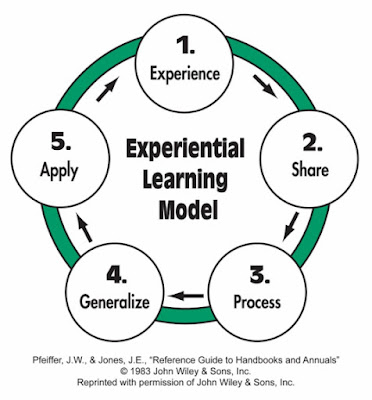Experiential Learning, with a brief example from an in-company workshop
The EXPERIENCE is individual, even if it takes place as part of a group activity.
During SHARING time, the experience is still individual, but part of it is made public to the extent that each participant decides.
When starting to PROCESS, we put some distance between us and what just happened, enough to get the necessary perspective to start internalizing it.
It is here, and especially in the next step, GENERALIZE, when it is appropriate to add theoretical information in any form considered more relevant and meaningful, and always with the goal in mind of helping the participants to internalize the experience so it becomes real learning.
Whether there is theoretical input or not, APPLYING the material generated up to this point (thoughts, feelings, sensations, ideas, models...) is a must in order to complete the cycle and optimize the quality and amount of learning.
After this, the cycle starts all over again, more in a spiral shape than as a circle: we go through the same cycle, but we take with us the learning from the previous one.
I include below a brief example to show the steps that more often get left out of learning activities: EXPERIENCE, SHARE, PROCESS, and APPLY.
Example from an in-company workshop
( EXPERIENCE )
A group of four heads of department from an online services company attends a workshop on interpersonal communication and communication across groups or teams. At the beginning of one of the sessions, they are asked to work individually, for a few minutes, on crafting a short, simple message in a made up language. Once they have it, they get in pairs for 5 minutes and work on trying to get each other's message across.
( SHARE )
Sitting in a circle, the four participants share with each other as much as they want to share about what they thought and felt during the exercise. A check-in format would be very useful here so that each one can share as much as they want with no interruptions, questions, or debate.
( PROCESS )
This is when, while remaining in the circle, the four participants and the facilitator engage in an open conversation about the exercise, and about what each one of them just shared. This is the time to process the experience through group conversation, NOT through theoretical study with resources brought in from outside the group.
( APPLY )
They're asked to hold a 10 minute meeting, during which they must focus predominantly on monitoring their communication process, and not so much on putting on the table what each one of them has to say. This meeting is an opportunity to use as resources their thoughts and feelings from the first exercise, their exchange of sensations, opinions, and ideas from the sharing and processing phases, all the theoretical material that the facilitator might have brought in, and their own personal and professional internalized resources.



Comments
Post a Comment